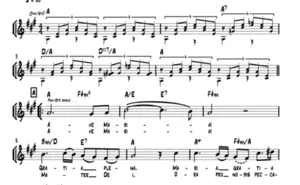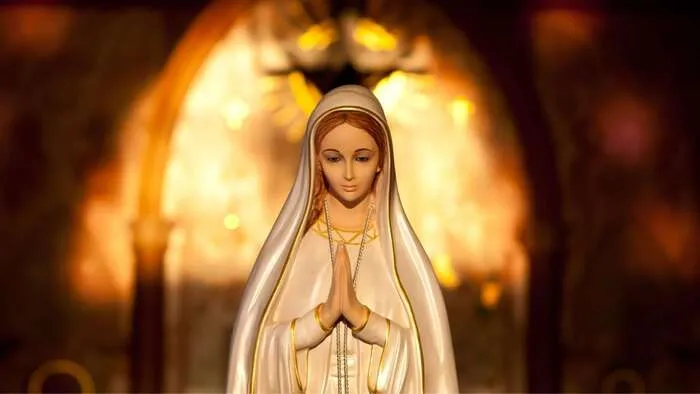“Ave Maria” is a prayer and a song that resonates deeply in the hearts of Christians around the world. Its history, variations and interpretations reveal a wealth of spiritual and cultural meanings.
Adverts
In this text, we explore the power and deep meaning of this work, recognizing its importance in the Christian faith.
Since its origins, the “Hail Mary” has been a central prayer in Christian devotion, particularly within Catholicism, reflecting the veneration of Mary, the mother of Jesus.
This prayer, transformed into music by various composers throughout history, such as Schubert, Bach/Gounod, and even in contemporary adaptations, has played a significant role in the liturgy and spiritual life of the faithful.
In addition to its profound theological meaning, the “Ave Maria” has been a meeting point between the divine and the human, facilitating a space for meditation, request for intercession and gratitude.
Origin and Structure from “Ave Maria”
The “Hail Mary” is made up of two main parts: the angel Gabriel’s greeting to Mary, and the prayer of the faithful asking for Mary’s intercession. This prayer incorporates biblical verses from Luke 1:28 and 1:42, expanding its theological and spiritual meaning over the centuries.
The beginning, taken from the Gospel of Luke, reflects the reverence and divine choice of Mary to be the mother of Jesus. “Full of grace” emphasizes the purity and uniqueness of Mary, chosen from the beginning by God, without the stain of original sin, prepared for the unique role of Mother of God.
This designation not only celebrates Mary's choice, but also her active role in salvation history, being venerated as the Theotokos, the bearer of God.
The second part of the prayer, a plea for intercession, reflects the deep desire of Christians to seek Mary's support and guidance in their lives.
By asking Mary to pray for us “now and at the hour of our death,” we express our trust in her maternal intercession, recognizing her closeness to Christ and her ongoing role in the community of believers.
Theological Meaning
The expression “full of grace” reflects the purity and uniqueness of Mary, chosen by God to be the mother of Jesus. This title is not just a greeting, but a recognition of her immaculate conception, predestined to be the living tabernacle of the Most High.
The prayer celebrates Mary's closeness to the Lord and her blessing among women, while requesting her intercession as Mother of God, highlighting her unique intercessory position with God on behalf of humanity.
This theological aspect highlights Mary's special position in the plan of salvation and her continuing influence on the lives of Christians. The use of this expression in the Hail Mary highlights the belief in the divine grace that surrounds it, making it a model of faith and obedience for all believers.
Through it, Christians learn the value of humility, total surrender to God's will and fervent prayer. Mary thus becomes not only the Mother of God but also the spiritual mother of all who seek to follow her example and achieve holiness.
She is venerated as the one who, through her response “let it be done to me according to your word”, allowed the incarnation of the Word, bringing the Savior into the world.
The “Hail Mary” in Art and Culture
The “Ave Maria” transcended the limits of prayer to become a masterpiece in music and the arts, exhibiting a universality that few pieces have managed to achieve.
Composers such as Schubert, Bach, and Gounod, each in their own way, brought this prayer to life with melodies that deeply touch the soul, illustrating music's extraordinary capacity to elevate the human spirit and connect the faithful to divinity in an intimate and profound way. .
These musical interpretations not only reinforce the power of the “Ave Maria” as an expression of faith, hope and love, but also as a vehicle for mystical and contemplative experience.

Furthermore, the “Ave Maria” has permeated diverse art forms, from literature to painting, sculpture and film, each exploring the richness of its spiritual and emotional message.
Role in Devotion and Prayer
Reciting the “Ave Maria” in the Rosary is not just a devotional practice; It is a spiritual journey that deepens the faithful's connection with the divine through contemplation of the mysteries of the lives of Jesus and Mary.
This act of devotion encourages Christians to delve into central events of the Christian faith, such as the birth, passion, death, and resurrection of Jesus, as well as significant moments in Mary's life.
By meditating on these mysteries while reciting the “Ave Maria”, the faithful enter a state of reflection that transcends everyday life, bringing them closer to teachings and divine love.
Furthermore, the “Ave Maria” acts as a reminder of the constant presence of God and the Virgin Mary in our lives, reinforcing the feeling of protection and spiritual guidance.
This spiritual connection is strengthened by repeating the prayer, which becomes a mantra that purifies the heart and mind, preparing the faithful to receive divine graces.
Conclusion
The “Hail Mary” is more than a simple prayer; It is a living expression of the Christian faith. Its profound theological significance and its influence on art and culture highlight the centrality of Mary in the Christian religion.
As such, the “Ave Maria” continues to inspire, comfort and guide the faithful on their spiritual path, reaffirming the beauty and depth of the Christian faith.
This prayer reflects not only a veneration for Mary, but also a deep spiritual connection with the divine, serving as a constant reminder of God's love and mercy towards humanity.
It resonates across different cultures and traditions, adapting while keeping its spiritual core intact, demonstrating the universality and timelessness of the Christian message.
Through his words, the faithful find comfort in moments of distress and strength in times of trial, making the “Ave Maria” a spiritual anchor for those who seek closeness to the sacred.
Its recitation is not only an act of devotion, but also an act of communion with the worldwide faith community, uniting Christians into one voice of hope and faith..




